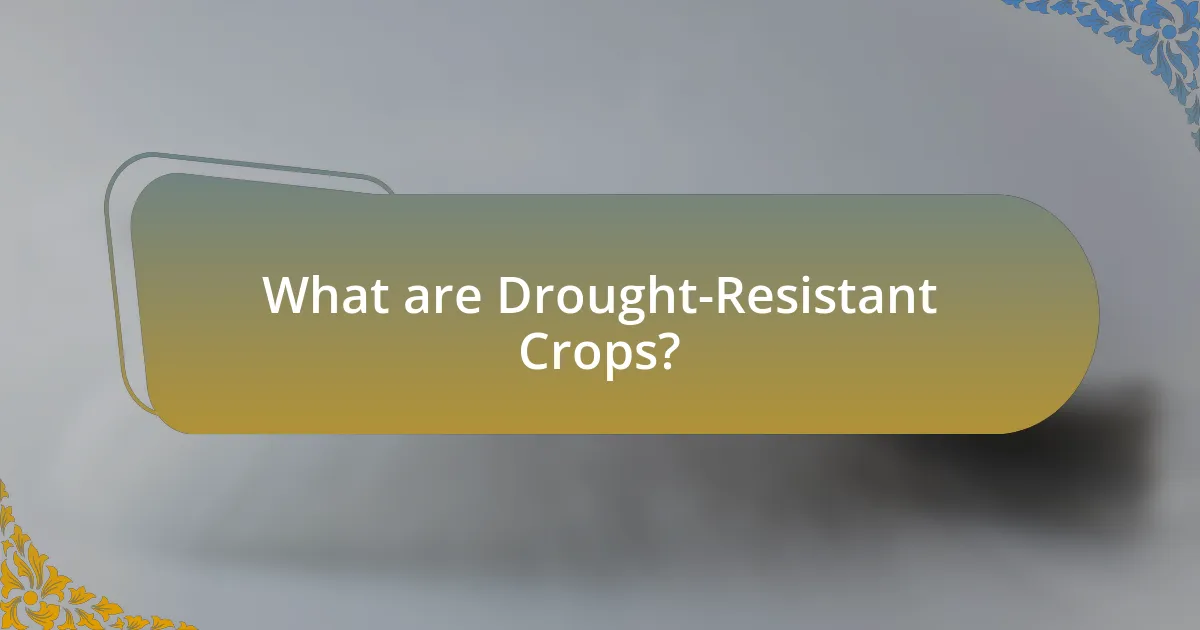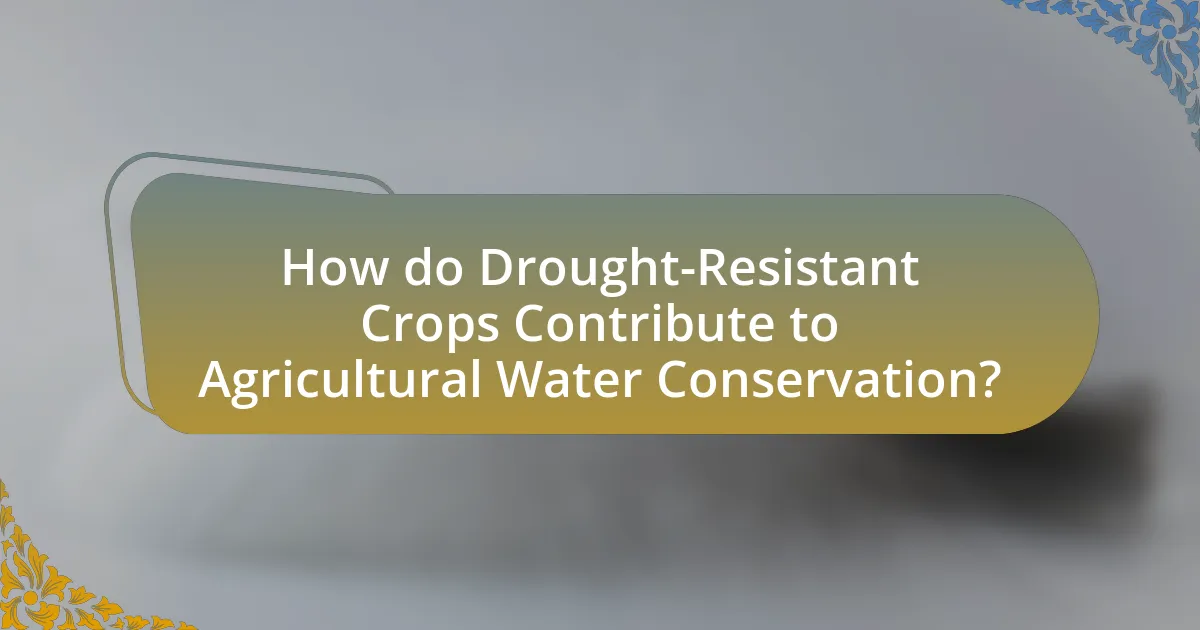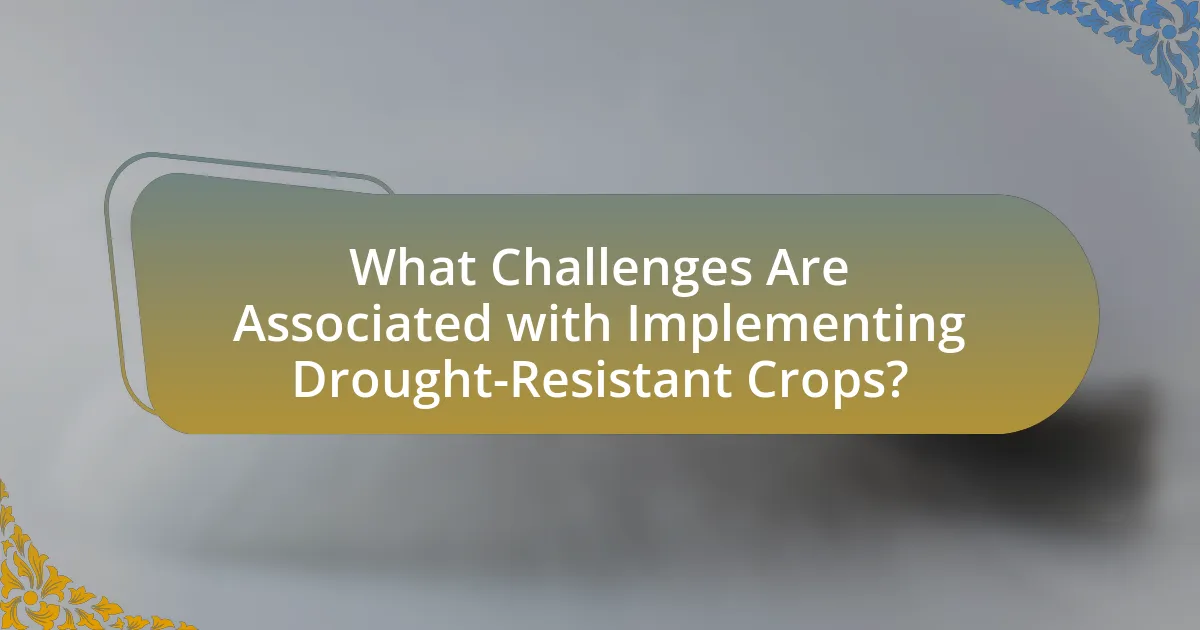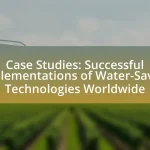Drought-resistant crops are specially bred or genetically modified plant varieties designed to thrive in low water availability conditions. This article examines the characteristics that differentiate these crops from traditional varieties, including their genetic traits that enhance water retention and reduce water loss. It highlights the importance of drought-resistant crops for agricultural sustainability, food security, and water conservation, particularly in the face of climate change. Additionally, the article addresses the challenges associated with their implementation, such as economic barriers and the need for farmer education, while outlining best practices and government policies that can facilitate their adoption.

What are Drought-Resistant Crops?
Drought-resistant crops are plant varieties specifically bred or genetically modified to withstand prolonged periods of low water availability. These crops possess traits such as deep root systems, reduced leaf area, or enhanced water retention capabilities, enabling them to survive and produce yields even in arid conditions. For instance, research has shown that drought-resistant varieties of maize can yield up to 30% more than traditional varieties under drought stress, demonstrating their effectiveness in agricultural water conservation.
How do drought-resistant crops differ from traditional crops?
Drought-resistant crops are genetically or selectively bred to withstand periods of low water availability, while traditional crops typically require more consistent moisture for optimal growth. Drought-resistant varieties often possess traits such as deeper root systems, reduced leaf area, or enhanced water retention capabilities, which allow them to survive in arid conditions. For example, research has shown that drought-resistant maize can yield up to 30% more than traditional maize in drought conditions, demonstrating their effectiveness in water-scarce environments.
What genetic traits contribute to drought resistance in crops?
Genetic traits that contribute to drought resistance in crops include deep root systems, efficient water use, and the ability to close stomata to reduce water loss. Deep root systems allow crops to access moisture from deeper soil layers, while efficient water use traits enable plants to maximize water uptake and minimize wastage. The ability to close stomata helps to conserve water during periods of drought. Research has shown that crops with these traits can maintain yield stability under water-limited conditions, thereby supporting agricultural sustainability and water conservation efforts. For example, studies have identified specific genes associated with these traits, such as the DREB (Dehydration-Responsive Element Binding) gene family, which plays a crucial role in plant responses to drought stress.
How do environmental conditions affect the performance of drought-resistant crops?
Environmental conditions significantly influence the performance of drought-resistant crops by affecting their growth, yield, and resilience. Factors such as soil moisture, temperature, and humidity directly impact the physiological processes of these crops, including water uptake and photosynthesis. For instance, research indicates that higher temperatures can lead to increased evapotranspiration, which may stress even drought-resistant varieties if soil moisture is insufficient. Additionally, soil quality and nutrient availability play crucial roles; crops in nutrient-rich soils tend to perform better under drought conditions compared to those in depleted soils. Studies have shown that drought-resistant crops can yield up to 30% more than traditional varieties under similar environmental stress, highlighting their potential in water-scarce regions.
Why are drought-resistant crops important for agriculture?
Drought-resistant crops are important for agriculture because they enhance food security and sustainability in water-scarce environments. These crops require less water to grow, which is crucial as global water resources become increasingly limited due to climate change and population growth. For instance, research indicates that drought-resistant varieties can yield up to 30% more than traditional crops under drought conditions, thereby ensuring a stable food supply. Additionally, the adoption of these crops can lead to reduced irrigation needs, conserving water resources and promoting more efficient agricultural practices.
What role do drought-resistant crops play in food security?
Drought-resistant crops significantly enhance food security by ensuring stable agricultural yields in water-scarce conditions. These crops are engineered or selected for their ability to thrive with limited water, which mitigates the risk of crop failure during droughts. For instance, research indicates that drought-resistant varieties of maize can yield up to 30% more than traditional varieties under drought conditions, thereby providing a reliable food source. This reliability is crucial as global populations rise and climate change increases the frequency of droughts, making drought-resistant crops essential for maintaining food supply and reducing hunger.
How can drought-resistant crops mitigate the effects of climate change?
Drought-resistant crops can mitigate the effects of climate change by reducing water usage and maintaining agricultural productivity in arid conditions. These crops are genetically engineered or selectively bred to withstand prolonged periods of drought, which allows farmers to conserve water resources while still producing food. For instance, research from the International Food Policy Research Institute indicates that adopting drought-resistant varieties can lead to a 20-30% increase in yield during dry spells, thereby enhancing food security and reducing the need for irrigation. This adaptation not only helps farmers cope with changing climate patterns but also contributes to sustainable agricultural practices by minimizing water depletion and preserving ecosystems.

How do Drought-Resistant Crops Contribute to Agricultural Water Conservation?
Drought-resistant crops significantly contribute to agricultural water conservation by reducing the amount of water needed for irrigation. These crops are genetically or selectively bred to withstand dry conditions, allowing them to thrive with less moisture. For instance, research has shown that drought-resistant varieties of maize can yield up to 30% more than traditional varieties under water-limited conditions, thereby minimizing the need for supplemental irrigation. This reduction in water usage not only conserves water resources but also enhances soil health and reduces the risk of erosion, further supporting sustainable agricultural practices.
What mechanisms do drought-resistant crops use to conserve water?
Drought-resistant crops conserve water through mechanisms such as deep root systems, reduced leaf area, and efficient stomatal regulation. Deep root systems allow these crops to access moisture from deeper soil layers, which is crucial during dry periods. Reduced leaf area minimizes transpiration, thereby decreasing water loss. Efficient stomatal regulation enables these plants to close their stomata during drought conditions, further conserving water by limiting gas exchange and transpiration. These adaptations have been observed in various drought-resistant species, demonstrating their effectiveness in enhancing water conservation in agriculture.
How does root depth influence water uptake in drought-resistant crops?
Root depth significantly influences water uptake in drought-resistant crops by allowing them to access deeper soil moisture reserves. Drought-resistant crops typically develop extensive root systems that penetrate deeper into the soil, enabling them to tap into water sources that are unavailable to crops with shallower roots. Research has shown that crops like sorghum and deep-rooted legumes can access moisture from depths of over 1 meter, which is crucial during prolonged dry periods. This adaptation not only enhances their survival during drought conditions but also contributes to improved water use efficiency, as these crops can maintain productivity with less reliance on surface water.
What physiological adaptations help reduce water loss in these crops?
Drought-resistant crops exhibit several physiological adaptations that help reduce water loss, including the development of thicker cuticles, reduced stomatal density, and enhanced root systems. Thicker cuticles minimize water evaporation from leaf surfaces, while reduced stomatal density decreases the number of openings through which water vapor can escape. Additionally, enhanced root systems allow these crops to access deeper soil moisture, further conserving water. These adaptations collectively enable crops to maintain hydration during periods of drought, thereby improving their resilience and sustainability in water-scarce environments.
What are the economic benefits of using drought-resistant crops for water conservation?
The economic benefits of using drought-resistant crops for water conservation include reduced irrigation costs and increased crop yields under water-scarce conditions. By requiring less water, drought-resistant crops lower the expenses associated with irrigation infrastructure and energy consumption for water delivery. For instance, a study by the International Water Management Institute found that adopting drought-resistant varieties can lead to savings of up to 30% in water usage, which translates to significant cost reductions for farmers. Additionally, these crops can maintain or enhance productivity during periods of drought, ensuring stable income and food supply, which is crucial for agricultural economies.
How can farmers reduce irrigation costs with drought-resistant crops?
Farmers can reduce irrigation costs by adopting drought-resistant crops, which require significantly less water than traditional varieties. These crops are genetically or naturally adapted to thrive in arid conditions, leading to lower water usage and reduced irrigation frequency. For instance, research indicates that drought-resistant varieties of crops like sorghum and millet can yield comparable or even higher outputs with 30-50% less water compared to conventional crops. This reduction in water demand directly translates to lower irrigation costs, as farmers spend less on water resources and energy for irrigation systems. Additionally, implementing these crops can enhance soil moisture retention, further decreasing the need for irrigation.
What impact do drought-resistant crops have on overall agricultural productivity?
Drought-resistant crops significantly enhance overall agricultural productivity by maintaining yields in water-scarce conditions. These crops are engineered or selected for their ability to withstand prolonged periods of drought, which allows farmers to produce food even when water availability is limited. For instance, studies have shown that drought-resistant varieties of maize can yield up to 30% more than traditional varieties under drought conditions, thereby stabilizing food supply and farmer income. This increased resilience not only supports food security but also reduces the economic risks associated with climate variability, making agriculture more sustainable in the face of changing environmental conditions.

What Challenges Are Associated with Implementing Drought-Resistant Crops?
Implementing drought-resistant crops faces several challenges, including the need for extensive research and development, potential market acceptance issues, and the requirement for farmer education and training. Research and development are essential to ensure that these crops are not only resilient to drought but also yield competitive harvests; for instance, developing new varieties can take years and significant investment. Market acceptance can be problematic as consumers may be hesitant to adopt genetically modified organisms or unfamiliar crop varieties, impacting demand. Additionally, farmers must be educated on the best practices for cultivating these crops, which may require changes in traditional farming methods and techniques. These challenges can hinder the widespread adoption of drought-resistant crops, despite their potential benefits for agricultural water conservation.
What are the barriers to adopting drought-resistant crops in different regions?
Barriers to adopting drought-resistant crops in different regions include economic constraints, lack of awareness, and inadequate infrastructure. Economic constraints arise from the high initial costs associated with developing and purchasing drought-resistant seeds, which can deter farmers, especially in low-income areas. Lack of awareness about the benefits and availability of these crops limits their adoption, as many farmers may not have access to information or education on sustainable agricultural practices. Additionally, inadequate infrastructure, such as poor irrigation systems and limited access to markets, hampers the ability of farmers to implement and benefit from drought-resistant crops effectively. These factors collectively hinder the widespread adoption of drought-resistant crops, impacting agricultural water conservation efforts.
How do socio-economic factors influence the adoption of drought-resistant crops?
Socio-economic factors significantly influence the adoption of drought-resistant crops by affecting farmers’ access to resources, knowledge, and financial incentives. For instance, farmers with higher income levels are more likely to invest in new technologies, including drought-resistant varieties, as they can afford the initial costs associated with these crops. Additionally, education plays a crucial role; farmers with better education are more likely to understand the benefits of drought-resistant crops and how to implement them effectively. Research indicates that regions with strong agricultural extension services see higher adoption rates of such crops, as these services provide essential training and support. Furthermore, market access and the availability of credit can determine whether farmers can purchase drought-resistant seeds and the necessary inputs for cultivation, thereby directly impacting their willingness to adopt these innovations.
What role does government policy play in promoting drought-resistant agriculture?
Government policy plays a crucial role in promoting drought-resistant agriculture by providing financial incentives, research funding, and regulatory frameworks that support the development and adoption of drought-resistant crops. For instance, policies such as subsidies for farmers who implement drought-resistant practices or grants for research institutions developing new crop varieties encourage innovation and adoption. Additionally, government initiatives like the USDA’s Conservation Reserve Program have been shown to enhance water conservation efforts by incentivizing landowners to adopt sustainable agricultural practices. These policies not only facilitate the transition to drought-resistant agriculture but also contribute to long-term water conservation and food security.
How can farmers overcome challenges in adopting drought-resistant crops?
Farmers can overcome challenges in adopting drought-resistant crops by implementing education and training programs that focus on the benefits and management of these crops. Research indicates that farmers who receive training on drought-resistant varieties are more likely to adopt them successfully, as they gain knowledge about optimal planting techniques and pest management strategies. For instance, a study published in the journal “Agricultural Systems” found that targeted extension services increased adoption rates by 30% among farmers in arid regions. Additionally, access to financial resources, such as grants or low-interest loans, can help farmers invest in drought-resistant seeds and necessary infrastructure. This multifaceted approach, combining education and financial support, effectively addresses the barriers to adopting drought-resistant crops.
What best practices can enhance the successful implementation of drought-resistant crops?
Best practices that can enhance the successful implementation of drought-resistant crops include selecting appropriate crop varieties, optimizing planting techniques, and employing effective water management strategies. Selecting crop varieties that are specifically bred for drought resistance ensures that the plants can thrive in low-water conditions, as evidenced by research showing that certain genetically modified crops can yield up to 30% more under drought stress compared to traditional varieties. Optimizing planting techniques, such as using minimum tillage and proper row spacing, can improve soil moisture retention and reduce evaporation. Effective water management strategies, including rainwater harvesting and drip irrigation, can significantly enhance water use efficiency, with studies indicating that drip irrigation can reduce water usage by up to 60% while maintaining crop yields. These practices collectively contribute to the successful implementation of drought-resistant crops, promoting agricultural sustainability in water-scarce regions.
How can education and resources support farmers in this transition?
Education and resources can support farmers in the transition to drought-resistant crops by providing essential knowledge and tools for effective implementation. Training programs can educate farmers on the benefits and cultivation techniques of drought-resistant varieties, which can lead to improved crop yields and reduced water usage. Access to research and data, such as studies from the International Water Management Institute, shows that adopting drought-resistant crops can decrease irrigation needs by up to 50%. Additionally, resources like financial assistance and access to technology enable farmers to invest in necessary infrastructure, further facilitating this transition.
What practical steps can be taken to maximize the benefits of drought-resistant crops?
To maximize the benefits of drought-resistant crops, farmers should implement soil moisture management techniques, such as mulching and cover cropping, to enhance water retention. These practices improve soil structure and reduce evaporation, allowing drought-resistant crops to thrive even in low-water conditions. Research indicates that mulching can reduce soil temperature and moisture loss by up to 30%, significantly benefiting crop yields during dry spells. Additionally, utilizing precision irrigation systems can optimize water usage, ensuring that drought-resistant crops receive adequate moisture without waste. Studies show that precision irrigation can increase water efficiency by 20-50%, further enhancing the effectiveness of drought-resistant varieties.


